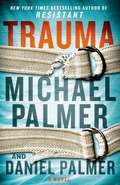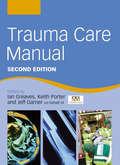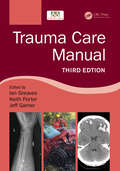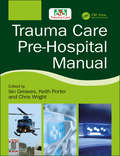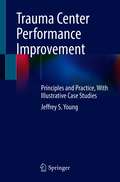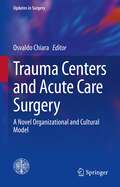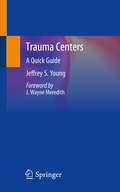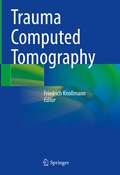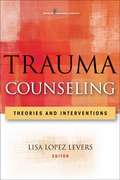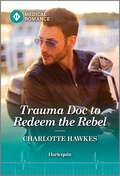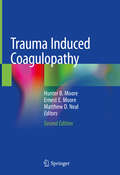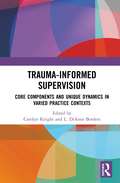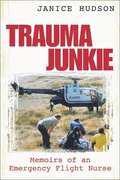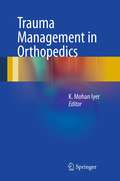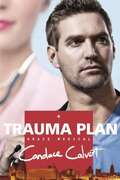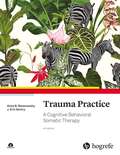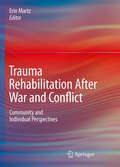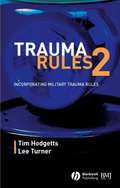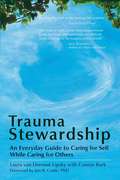- Table View
- List View
Trauma
by Michael Palmer Daniel PalmerDr. Carrie Bryant's four years as a neurosurgical resident at White Memorial Hospital have earned her the respect and admiration from peers and staff alike. When given the chance of performing her first unsupervised brain surgery, Carrie jumps at the opportunity. What should have been a routine, hours long operation, turns horribly wrong and jeopardizes her patient's life. Emotionally and physically drained, Carrie is rushed back to the OR to assist in a second surgery. There, she makes a careless and tragic mental error resulting in irreparable brain damage to her second patient. With her confidence shattered, Carrie quits her residency and moves back home where her younger brother, Adam, a combat vet suffering from debilitating PTSD, also lives. When Carrie learns about an experimental program at the VA Medical Center exploring the use of Deep Brain Stimulation (DBS) that could forever cure the emotional and memory trauma of PTSD, it seems like a way back into medicine. Carrie is apprehensive, but a chance meeting with David Hoffman, a reporter for the Lowell Observer writing a story on PTSD, helps her overcome any hesitation. Her first surgery appears to be a success until her patient mysteriously vanishes. When a second patient also goes missing, Carrie employees the investigative skills of David, and together they descend into a labyrinth of murder and corruption. And the price Carrie might pay for asking the wrong questions could be her life.
Trauma Anesthesia
by MPH FACS Charles E. Smith Charles E. Smith Md John J. Como John J. ComoTrauma patients present a unique challenge to anesthesiologists, since they require resource-intensive care, often complicated by pre-existing medical conditions. This fully revised new edition focuses on a broad spectrum of traumatic injuries and the procedures anesthesiologists perform to care for trauma patients perioperatively, surgically, and post-operatively. Special emphasis is given to assessment and treatment of co-existing disease, including surgical management of trauma patients with head, spine, orthopedic, cardiac, and burn injuries. Topics such as training for trauma (including use of simulation) and hypothermia in trauma are also covered. Six brand new chapters address pre-hospital and ED trauma management, imaging in trauma, surgical issues in head trauma and in abdominal trauma, anesthesia for oral and maxillofacial trauma, and prevention of injuries. The text is enhanced with numerous tables and 300 illustrations showcasing techniques of airway management, shock resuscitation, echocardiography and use of ultrasound for the performance of regional anesthesia in trauma.
Trauma Biomechanics
by Kai-Uwe Schmitt Peter F. Niederer Duane S. Cronin Markus H. Muser Felix WalzFor the 4th edition of Trauma Biomechanics all existing chapters referring to traffic and sports have been revised and updated. New scientific knowledge and changes in legal defaults (such as norms and standards of crash tests) have been integrated. Additionally one chapter has been added where biomechanical aspects of injuries affected by high energies are communicated in a new way The mechanical basics for ballistics and explosions are described and the respective impacts on human bodies are discussed. The new edition with the additional chapter therefore is addressed to a broader audience than the previous one.
Trauma Biomechanics: Accidental Injury In Traffic And Sports
by Kai-Uwe Schmitt Peter F. Niederer Duane S. Cronin Markus H. Muser Felix Walz Barclay Morrison IIIThis well-established book on injury biomechanics has been extensively revised and expanded for this new edition. It now includes a fundamental treatment of the mechanics at a cellular level, written by the new coauthor Prof. Barclay Morrison III from Columbia University. Furthermore, considerably more attention is paid to computer modeling, and in particular modeling the human body. <P><P> The book addresses a wide range of topics in injury biomechanics, including anatomy, injury classification, injury mechanisms, and injury criteria. Further, it provides essential information on regional injury reference values, or injury criteria, that are either currently in use or proposed by both US and European communities. Although the book is intended as an introduction for doctors and engineers who are newcomers to the field of injury biomechanics, sufficient references are provided for those who wish to conduct further research, and even established researchers will find it useful as a reference guide to the biomechanical background of each proposed injury mechanism and injury criterion.
Trauma Care Manual
by Keith Porter Ian Greaves Jeff GarnerThe Trauma Care Manual was first published in 2000, and was the first evidence-based manual of best trauma practice. Now in its second edition, it continues to offer clear and practical guidelines for the management of victims of major trauma, reflecting current practice in the United Kingdom and Europe.The second edition benefits from an increase
Trauma Care Manual
by Keith Porter Ian Greaves Jeff GarnerThe Trauma Care Manual 3e is the definitive evidence-based manual of best trauma practice. Now in its third edition, this valuable book continues to provide clear practical guidelines for the management of victims of major trauma. New coverage includes chapters on abdominal and urological trauma, aswell as trauma in the obese patient. Also included is coverage of pre-hospital management; trauma centres, sytems & teams; modern trauma resuscitation; trauma physiology & metabolism; damage control surgery. Written by members of Trauma Care, this book offers a nationally accepted set of standards for good practice.
Trauma Care Pre-Hospital Manual
by Chris Wright Keith Porter Ian GreavesThis new book provides evidence based guidelines for the immediate clinical management of major trauma.It has been written by clinicians with many years of trauma experience, and endorsed as authoritative by Trauma Care (UK). The UK now has highly effective trauma systems. Clinical developments include the introduction of damage control resuscitation, tranexamic acid, blood product resuscitation, novel hybrid resuscitation and an emphasis on the control of major external haemorrhage as part of a new ABCDE approach. Consequently, more individuals with major trauma are surviving than ever before. Optimal pre-hospital care is essential for improved survival rates and reduced morbidity.
Trauma Center Performance Improvement: Principles and Practice, With Illustrative Case Studies
by Jeffrey S. YoungManaging a trauma center involves complex clinical care, long nights and days, administrative work, self-examination, critical review of patient care and significant regulatory requirements. Performance improvement is the key element of trauma center effectiveness. No trauma center provides flawless care, thus all centers have opportunities to improve. A competent performance improvement program is critical to trauma center outcomes.This book provides key information on all aspects of trauma PI and program management. In some ways, PI is an art more than a science, so the more interaction program leaders have with strong PI programs, the more they can learn about how to improve their processes. The book outlines the generally accepted processes for identification of opportunities for improvement, which are the key component of performance improvement. This includes: rounding with care teams, contemporaneous chart review, audit filters, and voluntary submissions to the trauma program for review.This book explains how to triage opportunities for improvement, analyze them, form corrective actions, and finally achieve loop closure. The book covers the roles of the personnel in the PI program, what is required to dissect the opportunity to determine action plans, how to document the entire process, and how to keep track of opportunities for improvement to ensure that your program is progressively improving care. The final sections of the book deal with specific opportunities for improvement, action plans, and loop closure through the use of case studies. The book serves as a follow-up to Dr. Jeffrey Young’s recently published book Trauma Centers, which serves as a quick guide to the key components of trauma center administration, management, and patient care.
Trauma Centers and Acute Care Surgery: A Novel Organizational and Cultural Model (Updates in Surgery)
by Osvaldo ChiaraThis book offers an overview of acute care surgery around the world, focusing on the four main branches of this novel subdiscipline: trauma, general emergencies, critical care, and rescue surgery. The book’s primary goal is to provide a general view of acute care surgery, while addressing the most important issues in depth.The content is divided into three parts, the first of which is dedicated to the general organization of trauma centers, including the composition of modern trauma teams. Protocols of activation and action for the trauma team, as well as damage control procedures both in the emergency room and in the surgical theatre, are described. The book also addresses the development of a trauma registry, together with the quality assessment process that can be applied.In turn, the second part describes the principal protocols for making diagnoses, with special attention to circumstances such as unstable hemodynamics, neurological deterioration, normal vital signs, and penetrating injuries. The book subsequently deals with the most important aspects of trauma to the abdomen, chest, and pelvis, with notes on both surgical and intensive care issues. Practical descriptions of how to treat principal injuries to various organs are also provided. Finally, the third part of the book is dedicated to the most frequent general surgical emergencies and rescue surgical approaches, and includes information on diagnostic support with point of care ultrasound and endoscopic advanced techniques. Presenting cutting-edge strategies, this book will be of interest to professionals involved in surgical and intensive care for emergency conditions, such as colonic perforations, obstructions, acute pancreatitis, biliary tree stones, and caustic injuries.
Trauma Centers: A Quick Guide
by Jeffrey S. YoungThis book is a quick guide to the key components of trauma center administration, management, and patient care. This book provides essential information for hospitals working toward trauma center designation, and for established trauma centers who want to improve their performance. This book provides trauma center personnel with a comprehensive overview of trauma center administrative structure, basic clinical operations, performance improvement and site visit preparation and examines the most common critical injuries seen by trauma centers to demonstrate how a properly functioning center addresses multiple priorities in critically ill patients. This book provides critical information for hospitals looking toward becoming a trauma center and established trauma centers that wants to improve their performance.
Trauma Computed Tomography
by Friedrich KnollmannThis book covers the use of computed tomography in trauma care. Over the last two decades, advancements in CT technology have significantly changed the technique and utilization patterns of computed tomography in trauma imaging. This book covers the entire spectrum of this application, structured by organ systems/body areas, corresponding to the subject structure and practice pattern of large academic radiology departments in the US. As a result, the reader benefits from the most advanced currently available sub-specialty expertise in the performance and interpretation of trauma CT studies. The book is intended to serve as an introduction to the subject as well as a reference to the trauma radiologist. Since current post graduate education in radiology does not offer any formally regulated fellowship training in this area, fellowship trained radiologists are typically not trained to cover the entire spectrum of trauma imaging that the practitioner may encounter when covering call assignments, especially outside of highly subspecialized academic medical centers. This book is intended to fill a need to provide subspecialized trauma CT training by integrating contributions from all involved radiology subspecialties in a single volume. This is an ideal guide for radiology residents, fellows, practicing radiologists, trauma surgeons, emergency medicine specialists, surgery residents and fellows, and interested medical students.
Trauma Counseling: Theories and Interventions
by Lisa Lopez LeversTrauma Counseling: Theories and Interventions is a much-needed textbook that focuses on relevant issues of traumatic, crisis-related, and disaster events from a systemic paradigm. The book discusses evidence-based trauma assessment and intervention techniques and integrates the latest findings from neuropsychology and psychopharmacology.
Trauma Doc to Redeem the Rebel
by Charlotte HawkesSparks fly with the trauma doc…but could she be the one to heal him? Find out in Charlotte Hawkes&’s latest Harlequin Medical Romance novel! WILL LETTING GO SET HIM FREE? Former army surgeon Connor is instantly drawn to ER doc Nell. She&’s beautiful, intelligent and the first person to really see him—ever. Rebel Connor has spent years running away from his painful past, relationships and himself. But since Nell understands being abandoned in childhood, as he was, could she be the one woman to finally break through his barriers…and redeem his barricaded heart?From Harlequin Medical: Life and love in the world of modern medicine.
Trauma Induced Coagulopathy
by Eduardo Gonzalez Hunter B. Moore Ernest E. MooreThis text is aimed at defining the current concepts that define trauma induced coagulopathy by critically analyzing the most up-to-date studies from a clinical and basic science perspective. It will serve as a reference source for any clinician interested in reviewing the pathophysiology, diagnosis, and management of the coagulopathic trauma patient, and the data that supports it. By meticulously describing the methodology of most traditional as well as state of the art coagulation assays the reader will have full understanding of the tests that are used to study trauma induced coagulopathy. The evolving use of blood products as well as recently introduced hemostatic medications are reviewed in detail. Trauma Induced Coagulopathy will also be a valuable source for quick reference to the clinician that is faced with specific clinical challenges when managing coagulopathy.
Trauma Induced Coagulopathy
by Hunter B. Moore Ernest E. Moore Matthew D. NealThe first edition of this publication was aimed at defining the current concepts of trauma induced coagulopathy by critically analyzing the most up-to-date studies from a clinical and basic science perspective. It served as a reference source for any clinician interested in reviewing the pathophysiology, diagnosis, and management of the coagulopathic trauma patient, and the data that supports it. By meticulously describing the methodology of most traditional as well as state of the art coagulation assays the reader is provided with a full understanding of the tests that are used to study trauma induced coagulopathy. With the growing interest in understanding and managing coagulation in trauma, this second edition has been expanded to 46 chapters from its original 35 to incorporate the massive global efforts in understanding, diagnosing, and treating trauma induced coagulopathy. The evolving use of blood products as well as recently introduced hemostatic medications is reviewed in detail. The text provides therapeutic strategies to treat specific coagulation abnormalities following severe injury, which goes beyond the first edition that largely was based on describing the mechanisms causing coagulation abnormalities.Trauma Induced Coagulopathy 2nd Edition is a valuable reference to clinicians that are faced with specific clinical challenges when managing coagulopathy.
Trauma Informed Supervision: Core Components and Unique Dynamics in Varied Practice Contexts
by Carolyn Knight Di BordersSurvivors of trauma are disproportionately represented in agencies providing a broad range of behavioral, social, and mental health services. Practitioners in these settings must understand and be able to respond to survivors of trauma in ways that are empowering, normalize and validate their experiences and reactions, and minimize the risk of retraumatization. Practitioners also will be indirectly traumatized as a result of their work with trauma survivors. <p><p> Practitioners’ ability to help clients with histories of trauma depends upon clinical supervision that is trauma-informed. The trauma-informed supervisor has the dual responsibility of enhancing supervisees’ skills as trauma-informed practitioners and helping them manage the impact their work has on them. <p> Nevertheless, many clinical supervisors only have limited knowledge and training in trauma and may not recognize either the needs of those whom they supervise or the clients their supervisees serve. This book compiles important recommendations from trauma-informed practitioners, supervisors, and researchers who share their professional reflections and personal stories based on their hands-on experiences across mental health and medical contexts.
Trauma Informed Support and Supervision for Child Protection Professionals: A Model For Those Working With Children Who Have Experienced Trauma, Abuse And Neglect And Their Families
by Fiona OatesThis book presents a narrative approach to creating a supportive environment for health and human service practitioners who work with vulnerable children and their families—one of the most difficult and complex areas of practice. People working in these environments are routinely exposed to violence and trauma and commonly experience symptoms of traumatic stress as a result. Traditionally, human service and health care service organisations have struggled to support practitioners who experience primary and secondary trauma in either a preventative context or post exposure. Using contemporary trauma theory, this book provides a trauma-informed support and supervision framework for supervisors and managers of practitioners that recognises the uniqueness of the practice field, the diversity of practitioners who undertake the work and the diversity of contexts in which they work. It will be required reading for all human service and health professionals, including social workers, psychologists and nurses as well as teachers, counsellors and youth workers.
Trauma Junkie: Memoirs of an Emergency Flight Nurse
by Janice HudsonMemoirs of a flight nurse on a helicopter sent out to take trauma patients to hospitals in California.
Trauma Management in Orthopedics
by K. Mohan IyerThis book has been written by established Orthopedic Surgeons who have become dedicated specialists within their particular subspecialty. They have contributed by writing highly detailed chapters that educate the reader with the basic science, accepted fundamentals and most recent trends within the full range of trauma management in orthopedics. It is intended that this well illustrated and highly informative text book to provide orthopedic surgeons in training with comprehensive and relevant core knowledge on all aspects of trauma management orthopedics, and will become an essential guide for surgeons in training, providing step by step approaches to performing initial diagnosis, surgical procedures and post operative management.
Trauma Plan (Grace Medical Ser. #1)
by Candace CalvertSidelined by injuries from a vicious assault, chaplain Riley Hale is eager to return to her former duties as an ER nurse. But how can she show she's competent when the hospital won't let her attempt even simple tasks? Determined to prove herself, Riley volunteers at a controversial urban free clinic despite her fears about the maverick doctor in charge. Dr. Jack Travis defends his clinic like he's commander of the Alamo. He'll fight the community's efforts to shut its doors, even if he must use Riley Hale's influential family name to make it happen. As Riley strives to regain her skills. Jack finds that she shares his compassion--and stirs his lonely heart. Riley senses that beneath Jack's rough exterior is a man she can believe in. But when clinic protests escalate and questions surface about his past, Jack goes into battle mode, and Riley wonders if it's dangerous to trust him with her heart. Heart-stopping and... heart melting. A great read and one for your keeper shelf."--LYNETTE EASON, award-winning, bestselling author of the Women of Justice series--
Trauma Practice: A Cognitive Behavioral Somatic Therapy
by Anna B. Baranowsky J. Eric GentryThis popular, practical resource for traumatologists has been fully updated and expanded. It remains a key toolkit of cognitive behavioral somatic therapy (CBST) techniques for clinicians who want to enhance their skills in treating trauma and for those in training. The authors focus on helping practitioners find the right tools to guide their traumatized clients towards growth and healing but now also lay a deeper emphasis on the preparatory phase for therapists, including the therapists’ own ability to self-regulate their autonomic system during client encounters.
Trauma Red
by Peter Rhee Gordon DillowThe incredible life story of the trauma surgeon who helped save Congresswoman Gabby Giffords--from his upbringing in South Korea and Africa to the gripping dramas he faces in a typical day as a medical genius.Congresswoman Gabby Giffords is a household name: most people remember that awful day in Arizona in 2011 when she was a victim of an act of violence that left six dead and thirteen wounded. What many people don't know is that it was Dr. Peter Rhee who played a vital role in her survival. Born in South Korea, Rhee moved with his family to Uganda where he watched his public health surgeon father remove a spear from a man's belly--and began his lifelong interest in medicine. What came next is this compelling portrait of how one becomes a world class trauma surgeon: the specialized training, the mindset to make critical decisions, and the practiced ability to operate on the human body. Dr. Rhee is so eminent that when President Clinton traveled to China, he was selected to accompany the president as his personal physician. In Trauma Red we learn how Rhee's experiences were born from the love and sacrifices of determined parents, and of Rhee's own quest to become as excellent a surgeon as possible. Trauma Red chronicles the patient cases Dr. Rhee has handled over two decades on two distinct battle fronts: In Iraq and Afghanistan, where he served as a frontline US Navy surgeon trying to save young American soldiers, and the urban zones of Los Angeles and Washington, DC, where he has been confronted by an endless stream of bloody victims of civilian violence and accidents. Tough and outspoken, Dr. Rhee isn't afraid to take on the politics of violence in America and a medical community that too often resists innovation. His story provides an inside look into a fascinating medical world, a place where lives are saved every day.
Trauma Rehabilitation After War and Conflict
by Erin Martz"As foreign assistance flows into post-conflict regions to rebuild economies, roads, and schools, it is important that development professionals retain a focus on the purely human element of rebuilding lives and societies. This book provides perspective on just how to begin that process so that the trauma people suffered is not passed on to future generations long after the violence has stopped." - Amy T. Wilson, Ph.D., Gallaudet University, Washington, DC "This ground-breaking text provides the reader with an excellent and comprehensive overview of the existing field of trauma rehabilitation. It also masterfully navigates the intricate relationships among theory, research, and practice leaving the reader with immense appreciation for its subject matter." - Hanoch Livneh, Hanoch Livneh, Ph.D., LPC, CRC, Portland State University Fear, terror, helplessness, rage: for soldier and civilian alike, the psychological costs of war are staggering. And for those traumatized by chronic armed conflict, healing, recovery, and closure can seem like impossible goals. Demonstrating wide-ranging knowledge of the vulnerabilities and resilience of war survivors, the collaborators on Trauma Rehabilitation after War and Conflict analyze successful rehabilitative processes and intervention programs in conflict-affected areas of the world. Its dual focus on individual and community healing builds on the concept of the protective "trauma membrane," a component crucial to coping and healing, to humanitarian efforts (though one which is often passed over in favor of rebuilding infrastructure), and to promoting and sustaining peace. The book's multiple perspectives--including public health, community-based systems, and trauma-focused approaches--reflect the complex psychological, social, and emotional stresses faced by survivors, to provide authoritative information on salient topics such as: Psychological rehabilitation of U.S. veterans, non-Western ex-combatants, and civilians Forgiveness and social reconciliation after armed conflict Psychosocial adjustment in the post-war setting Helping individuals heal from war-related rape The psychological impact on prisoners of war Rehabilitating the child soldier Rehabilitation after War and Conflict lucidly sets out the terms for the next stage of humanitarian work, making it essential reading for researchers and professionals in psychology, social work, rehabilitation, counseling, and public health.
Trauma Rules 2: Incorporating Military Trauma Rules
by Timothy J. Hodgetts Lee TurnerTrauma Rules 2 retains its lively and fun presentation to help you remember the essential principles of trauma care and feel confident about handling and treating patients appropriately in the first hours of injury. Thoroughly expanded and updated, and now including military trauma rules, the second edition of this popular pocket book now offers: 70 easy-to-memorize rules covering the important aspects of trauma care clear, authoritative explanations and instructive illustrations the three principal stages of trauma management: approach to the patient, initial assessment and resuscitation, and investigation and definitive care Trauma Rules 2 is compiled especially for those dealing with the immediate and early management of the severely injured patient.
Trauma Stewardship: An Everyday Guide to Caring for Self While Caring for Others (Bk Life. Ser.)
by Connie Burk Laura van Dernoot LipskyThis beloved bestseller—over 180,000 copies sold—has helped caregivers worldwide keep themselves emotionally, psychologically, spiritually, and physically healthy in the face of the sometimes overwhelming traumas they confront every day.A longtime trauma worker, Laura van Dernoot Lipsky offers a deep and empathetic survey of the often-unrecognized toll taken on those working to make the world a better place. We may feel tired, cynical, or numb or like we can never do enough. These, and other symptoms, affect us individually and collectively, sapping the energy and effectiveness we so desperately need if we are to benefit humankind, other living things, and the planet itself. In Trauma Stewardship, we are called to meet these challenges in an intentional way. Lipsky offers a variety of simple and profound practices, drawn from modern psychology and a range of spiritual traditions, that enable us to look carefully at our reactions and motivations and discover new sources of energy and renewal. She includes interviews with successful trauma stewards from different walks of life and even uses New Yorker cartoons to illustrate her points."We can do meaningful work in a way that works for us and for those we serve," Lipsky writes. "Taking care of ourselves while taking care of others allows us to contribute to our societies with such impact that we will leave a legacy informed by our deepest wisdom and greatest gifts instead of burdened by our struggles and despair."
